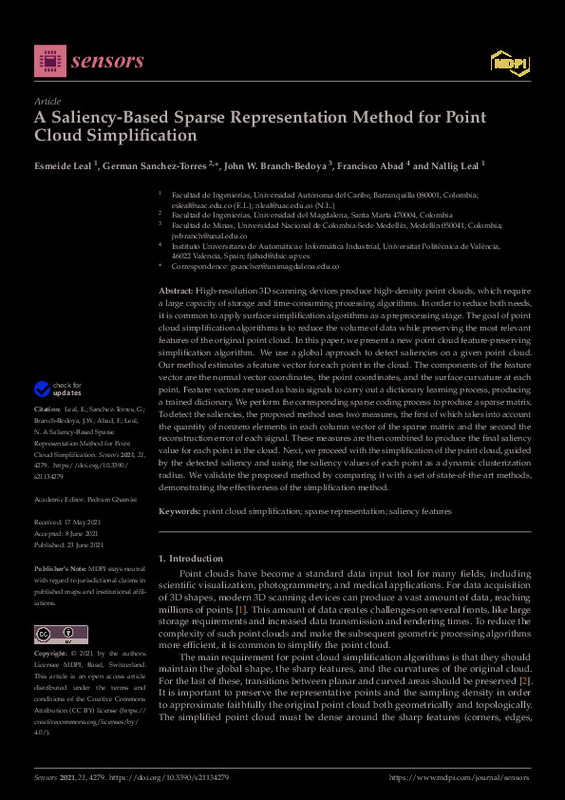JavaScript is disabled for your browser. Some features of this site may not work without it.
Buscar en RiuNet
Listar
Mi cuenta
Estadísticas
Ayuda RiuNet
Admin. UPV
A Saliency-Based Sparse Representation Method for Point Cloud Simplification
Mostrar el registro sencillo del ítem
Ficheros en el ítem
| dc.contributor.author | Leal, Esmeide
|
es_ES |
| dc.contributor.author | Sanchez-Torres, German
|
es_ES |
| dc.contributor.author | Branch-Bedoya, John W.
|
es_ES |
| dc.contributor.author | Abad Cerdá, Francisco José
|
es_ES |
| dc.contributor.author | Leal, Nallig
|
es_ES |
| dc.date.accessioned | 2023-04-06T18:01:06Z | |
| dc.date.available | 2023-04-06T18:01:06Z | |
| dc.date.issued | 2021-07 | es_ES |
| dc.identifier.uri | http://hdl.handle.net/10251/192748 | |
| dc.description.abstract | [EN] High-resolution 3D scanning devices produce high-density point clouds, which require a large capacity of storage and time-consuming processing algorithms. In order to reduce both needs, it is common to apply surface simplification algorithms as a preprocessing stage. The goal of point cloud simplification algorithms is to reduce the volume of data while preserving the most relevant features of the original point cloud. In this paper, we present a new point cloud feature-preserving simplification algorithm. We use a global approach to detect saliencies on a given point cloud. Our method estimates a feature vector for each point in the cloud. The components of the feature vector are the normal vector coordinates, the point coordinates, and the surface curvature at each point. Feature vectors are used as basis signals to carry out a dictionary learning process, producing a trained dictionary. We perform the corresponding sparse coding process to produce a sparse matrix. To detect the saliencies, the proposed method uses two measures, the first of which takes into account the quantity of nonzero elements in each column vector of the sparse matrix and the second the reconstruction error of each signal. These measures are then combined to produce the final saliency value for each point in the cloud. Next, we proceed with the simplification of the point cloud, guided by the detected saliency and using the saliency values of each point as a dynamic clusterization radius. We validate the proposed method by comparing it with a set of state-of-the-art methods, demonstrating the effectiveness of the simplification method. | es_ES |
| dc.description.sponsorship | This research was supported by the Administrative Department of Science and Technology of Colombia (COLCIENCIAS) under the doctoral scholarship program COLCIENCIAS 2015-727 and by The Universidad Nacional de Colombia campus Medellin. | es_ES |
| dc.language | Inglés | es_ES |
| dc.publisher | MDPI AG | es_ES |
| dc.relation.ispartof | Sensors | es_ES |
| dc.rights | Reconocimiento (by) | es_ES |
| dc.subject | Point cloud simplification | es_ES |
| dc.subject | Sparse representation | es_ES |
| dc.subject | Saliency features | es_ES |
| dc.subject.classification | LENGUAJES Y SISTEMAS INFORMATICOS | es_ES |
| dc.title | A Saliency-Based Sparse Representation Method for Point Cloud Simplification | es_ES |
| dc.type | Artículo | es_ES |
| dc.identifier.doi | 10.3390/s21134279 | es_ES |
| dc.relation.projectID | info:eu-repo/grantAgreement/COLCIENCIAS//2015-727/ | es_ES |
| dc.rights.accessRights | Abierto | es_ES |
| dc.contributor.affiliation | Universitat Politècnica de València. Escola Tècnica Superior d'Enginyeria Informàtica | es_ES |
| dc.description.bibliographicCitation | Leal, E.; Sanchez-Torres, G.; Branch-Bedoya, JW.; Abad Cerdá, FJ.; Leal, N. (2021). A Saliency-Based Sparse Representation Method for Point Cloud Simplification. Sensors. 21(13):1-19. https://doi.org/10.3390/s21134279 | es_ES |
| dc.description.accrualMethod | S | es_ES |
| dc.relation.publisherversion | https://doi.org/10.3390/s21134279 | es_ES |
| dc.description.upvformatpinicio | 1 | es_ES |
| dc.description.upvformatpfin | 19 | es_ES |
| dc.type.version | info:eu-repo/semantics/publishedVersion | es_ES |
| dc.description.volume | 21 | es_ES |
| dc.description.issue | 13 | es_ES |
| dc.identifier.eissn | 1424-8220 | es_ES |
| dc.identifier.pmid | 34201455 | es_ES |
| dc.identifier.pmcid | PMC8271750 | es_ES |
| dc.relation.pasarela | S\443087 | es_ES |
| dc.contributor.funder | Universidad Nacional de Colombia | es_ES |
| dc.contributor.funder | Departamento Administrativo de Ciencia, Tecnología e Innovación, Colombia | es_ES |








